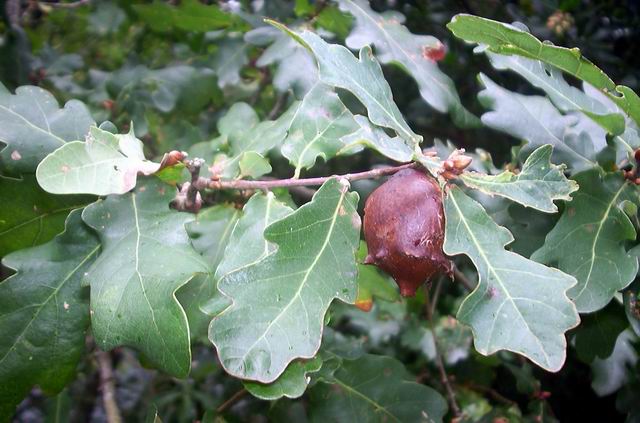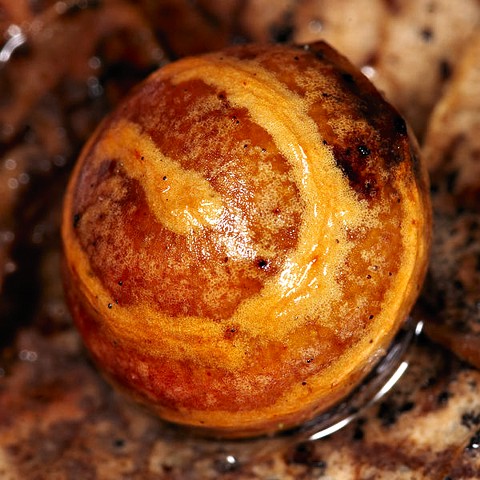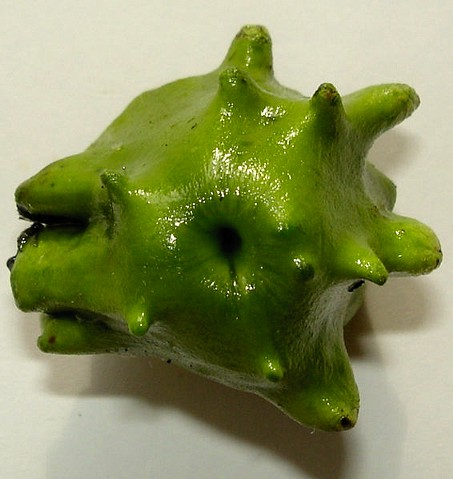Lessico
Noce
di galla
Cecidio

Noce di galla in una quercia
La noce di
galla è detta anche cecidio![]() .
Il termine latino galla ha il significato
di escrescenza. La noce di galla è un cecidio prodotto dalla puntura di vari
insetti appartenenti alla famiglia Cynipidae
sul tronco, sulle foglie o sulle radici di alcune piante. Per
estensione, vescichetta sierosa che si produce sulla pelle dell'uomo in
seguito a punture di insetti, a scottature o altro.
.
Il termine latino galla ha il significato
di escrescenza. La noce di galla è un cecidio prodotto dalla puntura di vari
insetti appartenenti alla famiglia Cynipidae
sul tronco, sulle foglie o sulle radici di alcune piante. Per
estensione, vescichetta sierosa che si produce sulla pelle dell'uomo in
seguito a punture di insetti, a scottature o altro.
Nelle noci di galla è comune la presenza di acido gallico o acido 3,4,5-tri-idrossibenzoico, che può essere presente allo stato libero o più spesso combinato sotto forma di glucoside o di tannino. Industrialmente si produce utilizzando colture di microrganismi (Penicillium glaucum, Sterygmatocystis nigra) che elaborano tannasi, enzima operante la scissione idrolitica dei tannini.
L'acido gallico è un forte riducente; le soluzioni acquose si ossidano rapidamente all'aria acquistando colore bruno; per trattamento con cloruro ferrico l'acido gallico forma un precipitato nero-azzurro. Tale reazione viene sfruttata per la preparazione degli inchiostri.
Nell'industria viene anche adoperato per la preparazione di antiossidanti di materiali per lo sviluppo fotografico, per la sintesi del pirogallolo. In analisi chimica è usato come reattivo per la ricerca degli alcaloidi. In medicina, alcuni derivati dell'acido gallico, quali il gallato basico di bismuto e l'ossiiodogallato di bismuto, vengono adoperati come antisettici succedanei dello iodoformio.
Cecidio – in greco këkídion = inchiostro di galla – è diminutivo di këkís/këkîdos che oltre al significato di succo, grasso, umore fatto colare dal fuoco, assume pure quello di galla della quercia e di inchiostro di galla. Si tratta di un’escrescenza ben localizzata e determinata, costituita da tessuti di natura ipertrofica o iperplastica, che si sviluppa in un organo vegetale come reazione patologica allo stimolo esercitatovi da un elemento parassita, il quale se ne serve come dimora durante il periodo di sviluppo, traendone anche alimento. Tale formazione anomala – nota anche genericamente con il nome di galla – con maggior precisione viene detta zoocecidio quando è originata da un parassita animale, fitocecidio se da un organismo vegetale.
Cynipidae
Cinipe deriva dal latino tardo sciniphe(n), derivato dal greco sknîphes, plurale di skníps ‘insetto roditore’, a sua volta derivato da skníptein ‘pungere, pizzicare’ (di etimologia incerta). Più o meno equivalente a skníps - e che forse più chiaramente ha dato luogo a cinipe - è kníps, usato nel senso di formica oppure di bruco che infesta le piante; kníps pare possa derivare da knáø = grattugiare, raschiare, grattare, solleticare. Aristotele in Historia animalium VIII,3 593a usa sia σκνιποφάφα per gli animali che mangiano σκνίπας, sia κνιπολόγος per indicare un uccello raccoglitore di formiche, o bruchi che siano. Basta così!!! Dimenticavo: etimologicamente parlando la y di Cynipidae andrebbe tramutata in i.
I Cynipidae costituiscono una famiglia di Insetti Imenotteri i cui membri, fitofagi, provocano a carico delle piante la formazione di cecidi o galle, escrescenze ben localizzate e determinate, costituite da tessuti di natura ipertrofica o iperplastica, che si sviluppano in un organo vegetale come reazione patologica allo stimolo esercitatovi da un elemento parassita, il quale se ne serve come dimora durante il periodo di sviluppo, traendone anche alimento.
Tra tutte
le piante, le querce sono quelle di gran lunga più frequentemente attaccate
dai Cinipedi; ben noto è l'elevato contenuto in acido gallico e tannico delle
galle, tale da giustificare lo sfruttamento di tali formazioni nella
fabbricazione dell'inchiostro e nella concia delle pelli. Il genere principale
è Cynips e la specie più nota è il cinipe di Kollar![]() (Cynips/Andricus
kollari).
(Cynips/Andricus
kollari).
Gall
wasps
Cynipidae
Gall wasps (Cynipidae), also called Gallflies, are a family of the order Hymenoptera and are classified with the Apocrita suborder of wasps in the superfamily Cynipoidea. About 1300 species of this generally very small creature (1-8 millimeters) are known worldwide, with about 360 species of 36 different genera in Europe and some 800 species in North America.
Features
Like all representatives of Apocrita, gall wasps have a distinctive body shape, the so-called wasp waist. The first abdominal tergum (the propodeum) is conjoined with the thorax, while the second abdominal segment forms a sort of shaft, the petiole. The petiole connects with the gaster, which is the functional abdomen in apocritan wasps, starting with the third abdominal segment proper. Together, the petiole and the gaster form the metasoma, while the thorax and the propodeum make up the mesosoma. The antennae are straight and consist of 12 to 16 segments. In many varieties the backside of the mesosoma appears longitudinally banded. The wings are typically simply structured. The female's egg-depositing ovipositor is often seen protruding from the tip of the metasoma.
Reproduction and Development
The reproduction of the gall wasp is partly pure two-sex propagation, partly pure parthenogenesis, in which a male is completely unnecessary. With most species, however, there is an alternation of generations with one two-sex generation and one parthenogenic generation annually. This process differentiates the various generations primarily in their appearance and the form of the plant galls they induce.
The larvae of most gall wasps develop in characteristic plant galls they induce themselves, however many species are also inquilines of other gall wasps, such as those of the genus Synergus.
The plant galls mostly develop directly after the female insect lays the eggs. The inducement for the gall formation is largely unknown; discussion speculates as to both chemical, mechanical and viral triggers. The hatching larvae nourish themselves with the nutritive tissue of the galls, in which they are otherwise well-protected from external environmental effects.
The host plants and the size and shape of the galls are specific to the majority of gall wasps, whereas about 70% of the known species live in various types of oak tree. One can find galls on nearly all parts of such trees, some on the leaves, the buds, the branches, and the roots. Other species of gall wasp live in rose bushes or maple trees, as well as many herbs. Frequently, the determination of the species is much easier through observation of the galls produced rather than the insect inself.
Types
Most species of gall wasp live as gall-formers on oaks. One of the most well-known of these oak gall wasps is the common oak gall wasp (Cynips quercusfolii), which induces characteristic two-centimeter in diameter, spherical galls on the underside of oak leaves.
These turn reddish in the fall and are commonly known as oak apples. Light lentiform galls on the underside of the same leaves are induced by Neuroterus quercusbaccarum; darker ones with bulging edges are formed by Neuroterus numismalis. Also striking are the galls of Cynips longiventris, which likewise can be found on the underside of leaves, and are recognizable for their spheroidal shape and irregular red streaks.

Gall of Cynips longiventris
The oak potato gall wasp (Biorrhiza pallida) has round galls that grow to about four centimeters. These are known colloquially as oak potatoes. The latter type of gall is induced by this type of wasp not on the leaves, but on the roots of the oak. On the buds of young oak twigs, one can often find the hard-shelled galls of Andricus kollari and Andricus quercustozae.
The galls of the rose gall wasp (Diplolepis rosae) are also distinctive and are known as bedeguars. These are found on the shoots of roses and have a length of up to five centimeters with red long-haired outgrowths. Inside the galls are several chambers, which may be occupied by larvae.
Andricus kollari (Hartig, 1843)
A
Marble Gall on the stem of Quercus robur.
The larvae causing these in summer are asexual. The adults lay eggs on Turkey
Oak Quercus cerris which form smaller galls containing a sexual
generation.
The adults from the marble galls may emerge in Autum as here, completing two
generations in a year; or in spring thus taking two years to complete the
cycle - this is more common in northern Britain.
These galls have spread from southwestern Britain since introduction in the
19th century.
This gall is about 18mm diameter. A complex collection of inquilines and
parasitoids may develop within.
Cambridge TL464614, 29 Aug 2002.
Andricus quercuscalicis (Burgsdorf, 1783)

These
growths on the acorns of Quercus robur are called Knopper Galls.
The larvae causing these in summer are asexual. Adults emerge in spring to
produce a new sexual generation on the catkins of Quercus cerris (itself
an invasive non-native species).
These galls have rapidly become widespread in Britain since they first
appeared about 1960.
Single galls are about 22mm across.
Cambridge TL464614, 21 Aug 2002.
Diplolepis rosae (Linnaeus, 1758)

Synonym Rhodites rosae
This
growth on a wild rose is called a Bedeguar Gall, or more picturesquely a
Robin's pincushion. (Bedeguar comes from a French, and ultimately a Persian,
word meaning 'wind-brought').
Several Diploepis rosae larvae form the gall, and they may been joined
by the harmless inquiline cynipid Periclistus brandtii (Ratzeburg) and
(as in marble galls) a complex ecology of parasitoids and hyperparasitoids.
The species consists almost exclusively of parthenogenic females.
This example is about 7cm in diameter.
Cambridge TL463614, 18 Jul 2002.
Diplolepsis quercus

